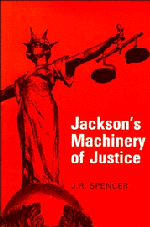Book contents
- Frontmatter
- Contents
- Acknowledgements
- List of figures
- List of tables
- Preface
- Preface to the first edition of ‘The Machinery of Justice in England’
- Abbreviations
- I Historical introduction
- II Civil jurisdiction
- III Tribunals
- IV Criminal jurisdiction
- 19 Courts with original criminal jurisdiction
- 20 Coroners' Courts
- 21 Courts with appellate criminal jurisdiction
- 22 The process of prosecution
- 23 Criminal procedure
- 24 The process of sentencing (including probation)
- 25 Juvenile courts
- 26 The matrimonial jurisdiction of magistrates – the Domestic Court
- V The personnel of the law
- VI The European dimension
- VII The cost of the law
- VIII Law Reform
- Appendix A The Report of the Civil Justice Review
- Table of Cases cited
- Table of Statutes cited
- Table of Stationery Office publications cited
- Index
19 - Courts with original criminal jurisdiction
Published online by Cambridge University Press: 10 January 2011
- Frontmatter
- Contents
- Acknowledgements
- List of figures
- List of tables
- Preface
- Preface to the first edition of ‘The Machinery of Justice in England’
- Abbreviations
- I Historical introduction
- II Civil jurisdiction
- III Tribunals
- IV Criminal jurisdiction
- 19 Courts with original criminal jurisdiction
- 20 Coroners' Courts
- 21 Courts with appellate criminal jurisdiction
- 22 The process of prosecution
- 23 Criminal procedure
- 24 The process of sentencing (including probation)
- 25 Juvenile courts
- 26 The matrimonial jurisdiction of magistrates – the Domestic Court
- V The personnel of the law
- VI The European dimension
- VII The cost of the law
- VIII Law Reform
- Appendix A The Report of the Civil Justice Review
- Table of Cases cited
- Table of Statutes cited
- Table of Stationery Office publications cited
- Index
Summary
Jurisdiction over serious crimes belongs to the Crown Court. This was created by the Courts Act 1971, and its constitutional document is now the Supreme Court Act 1981. This legal entity is usually spoken and written about as if it were a number of separate courts – ‘Cambridge Crown Court’, ‘Snaresbrook Crown Court’ and so forth. However, like the High Court, the Crown Court is really one single court with a number of branches operating in various places simultaneously. There are some 90 different Crown Court centres, one in every substantial town. The theory that the Crown Court is a single entity has an important legal consequence, namely that Crown Court jurisdiction is not territorial: a serious crime can be tried at the Crown Court in any part of the country, whether near or far from the place where it was committed. Trial in the Crown Court takes place before a legally qualified judge and, if there is a plea of ‘not guilty’, a jury. For the most serious offences the judge will be a High Court Judge, but most indictments are tried before a lower grade of full-time professional judge called a Circuit Judge, or a part-time legally-qualified judge called a Recorder or Assistant Recorder.
- Type
- Chapter
- Information
- Jackson's Machinery of Justice , pp. 171 - 193Publisher: Cambridge University PressPrint publication year: 1989

